Environmental Impacts of Oil and Gas Industry in UK - Report
VerifiedAdded on 2020/02/05
|14
|2964
|111
Report
AI Summary
This report provides a comprehensive overview of the environmental management of the oil and gas industry, focusing on the UK context. It examines the industry from exploration to refining, detailing the potential environmental hazards, including air and water pollution, impacts on marine life, and socio-economic effects. The report highlights specific environmental impacts such as oil spills, emissions, and habitat degradation. It also analyzes the approaches and strategies employed to mitigate these impacts, including pollution control measures, water management plans, and emergency response protocols. The report further discusses the role of government bodies like the Department of Energy and Climate Change (DECC) and the Health and Safety Executive (HSE) in regulating the industry and ensuring environmental compliance. The report concludes with a call for minimizing the environmental impacts to ensure a sustainable future for the industry in the UK. The report provides tables and figures illustrating key data and trends related to oil production, gas reserves, and pollution discharges.
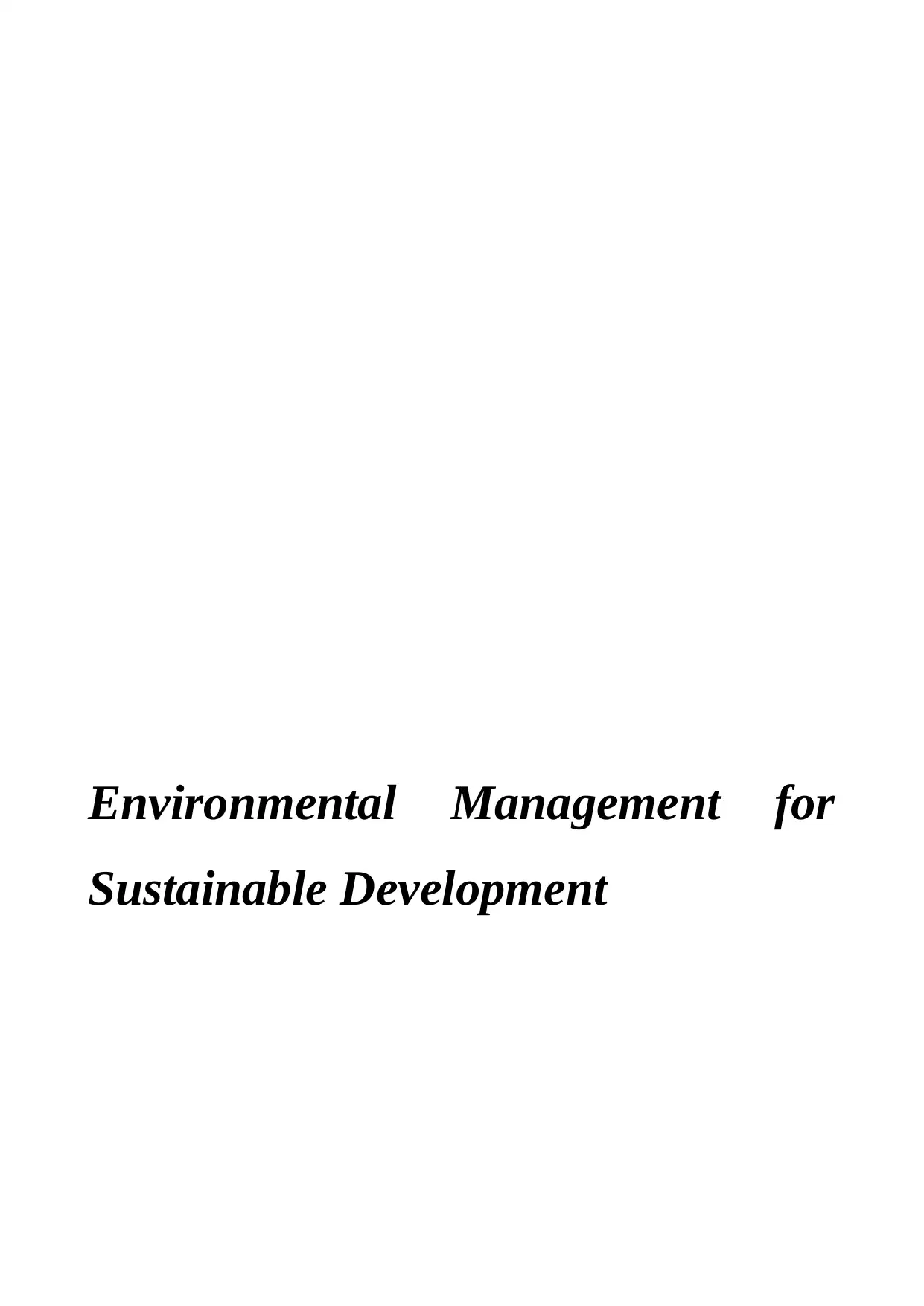
Environmental Management for
Sustainable Development
Sustainable Development
Paraphrase This Document
Need a fresh take? Get an instant paraphrase of this document with our AI Paraphraser
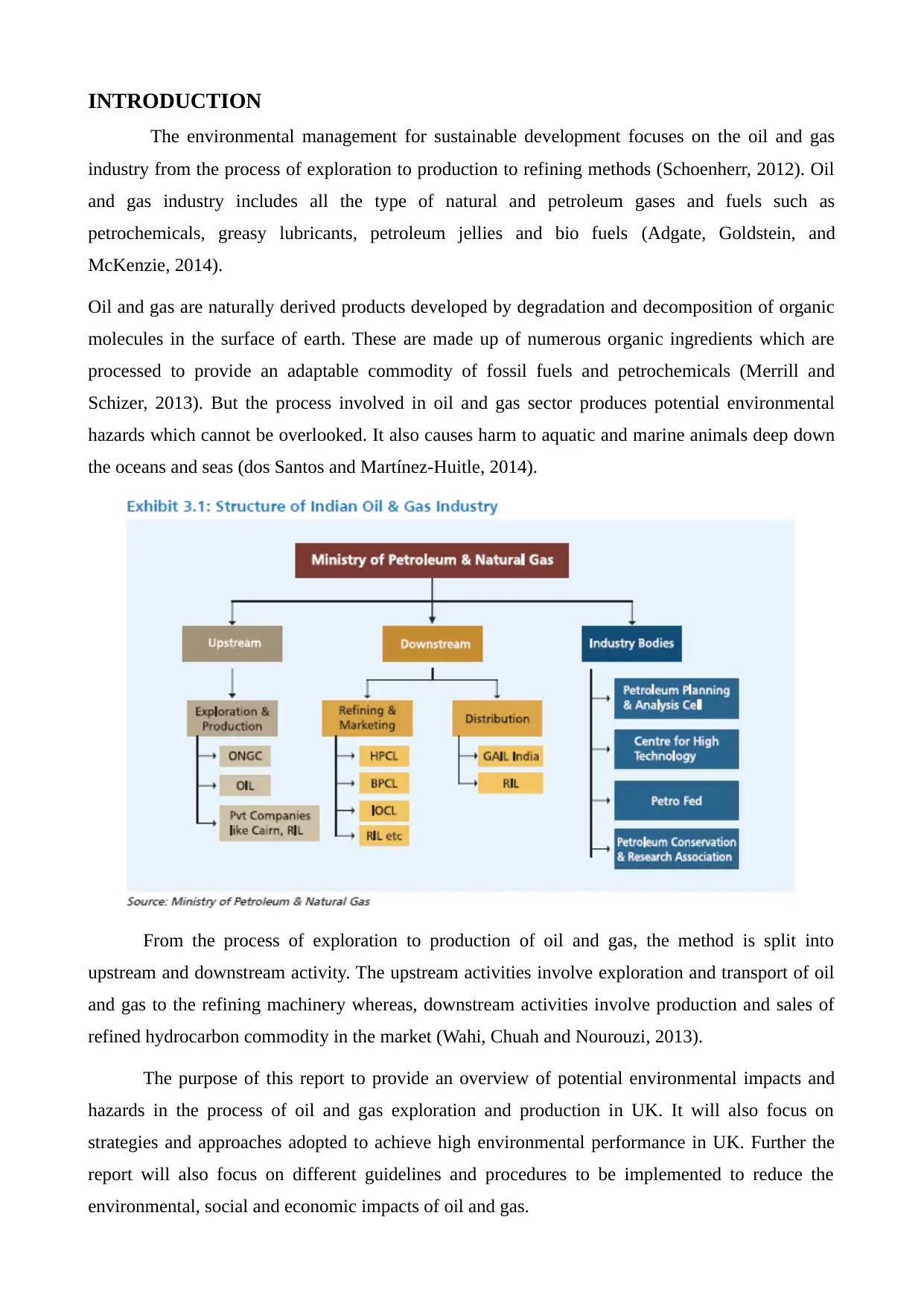
INTRODUCTION
The environmental management for sustainable development focuses on the oil and gas
industry from the process of exploration to production to refining methods (Schoenherr, 2012). Oil
and gas industry includes all the type of natural and petroleum gases and fuels such as
petrochemicals, greasy lubricants, petroleum jellies and bio fuels (Adgate, Goldstein, and
McKenzie, 2014).
Oil and gas are naturally derived products developed by degradation and decomposition of organic
molecules in the surface of earth. These are made up of numerous organic ingredients which are
processed to provide an adaptable commodity of fossil fuels and petrochemicals (Merrill and
Schizer, 2013). But the process involved in oil and gas sector produces potential environmental
hazards which cannot be overlooked. It also causes harm to aquatic and marine animals deep down
the oceans and seas (dos Santos and Martínez-Huitle, 2014).
From the process of exploration to production of oil and gas, the method is split into
upstream and downstream activity. The upstream activities involve exploration and transport of oil
and gas to the refining machinery whereas, downstream activities involve production and sales of
refined hydrocarbon commodity in the market (Wahi, Chuah and Nourouzi, 2013).
The purpose of this report to provide an overview of potential environmental impacts and
hazards in the process of oil and gas exploration and production in UK. It will also focus on
strategies and approaches adopted to achieve high environmental performance in UK. Further the
report will also focus on different guidelines and procedures to be implemented to reduce the
environmental, social and economic impacts of oil and gas.
The environmental management for sustainable development focuses on the oil and gas
industry from the process of exploration to production to refining methods (Schoenherr, 2012). Oil
and gas industry includes all the type of natural and petroleum gases and fuels such as
petrochemicals, greasy lubricants, petroleum jellies and bio fuels (Adgate, Goldstein, and
McKenzie, 2014).
Oil and gas are naturally derived products developed by degradation and decomposition of organic
molecules in the surface of earth. These are made up of numerous organic ingredients which are
processed to provide an adaptable commodity of fossil fuels and petrochemicals (Merrill and
Schizer, 2013). But the process involved in oil and gas sector produces potential environmental
hazards which cannot be overlooked. It also causes harm to aquatic and marine animals deep down
the oceans and seas (dos Santos and Martínez-Huitle, 2014).
From the process of exploration to production of oil and gas, the method is split into
upstream and downstream activity. The upstream activities involve exploration and transport of oil
and gas to the refining machinery whereas, downstream activities involve production and sales of
refined hydrocarbon commodity in the market (Wahi, Chuah and Nourouzi, 2013).
The purpose of this report to provide an overview of potential environmental impacts and
hazards in the process of oil and gas exploration and production in UK. It will also focus on
strategies and approaches adopted to achieve high environmental performance in UK. Further the
report will also focus on different guidelines and procedures to be implemented to reduce the
environmental, social and economic impacts of oil and gas.
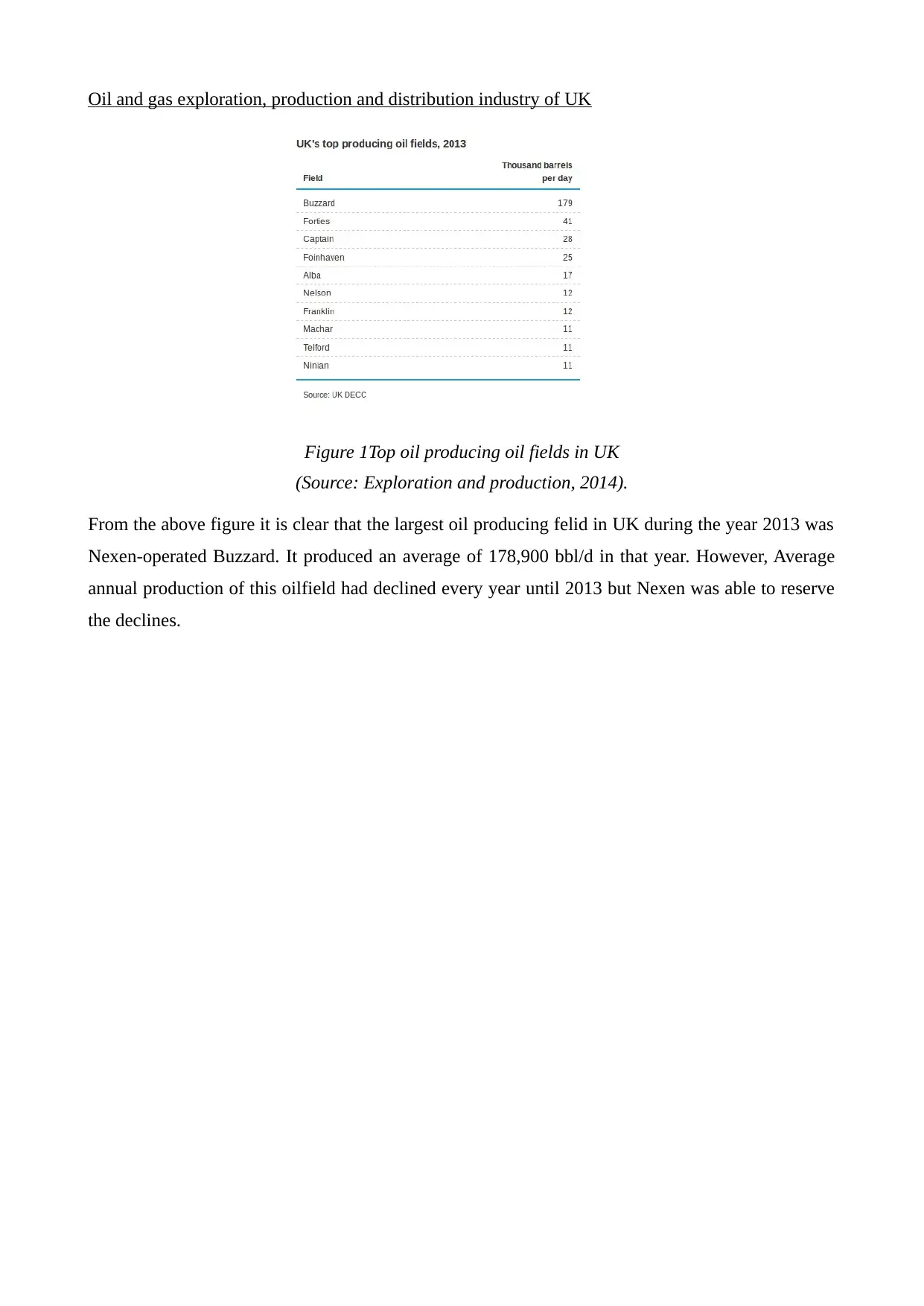
Oil and gas exploration, production and distribution industry of UK
Figure 1Top oil producing oil fields in UK
(Source: Exploration and production, 2014).
From the above figure it is clear that the largest oil producing felid in UK during the year 2013 was
Nexen-operated Buzzard. It produced an average of 178,900 bbl/d in that year. However, Average
annual production of this oilfield had declined every year until 2013 but Nexen was able to reserve
the declines.
Figure 1Top oil producing oil fields in UK
(Source: Exploration and production, 2014).
From the above figure it is clear that the largest oil producing felid in UK during the year 2013 was
Nexen-operated Buzzard. It produced an average of 178,900 bbl/d in that year. However, Average
annual production of this oilfield had declined every year until 2013 but Nexen was able to reserve
the declines.
⊘ This is a preview!⊘
Do you want full access?
Subscribe today to unlock all pages.

Trusted by 1+ million students worldwide
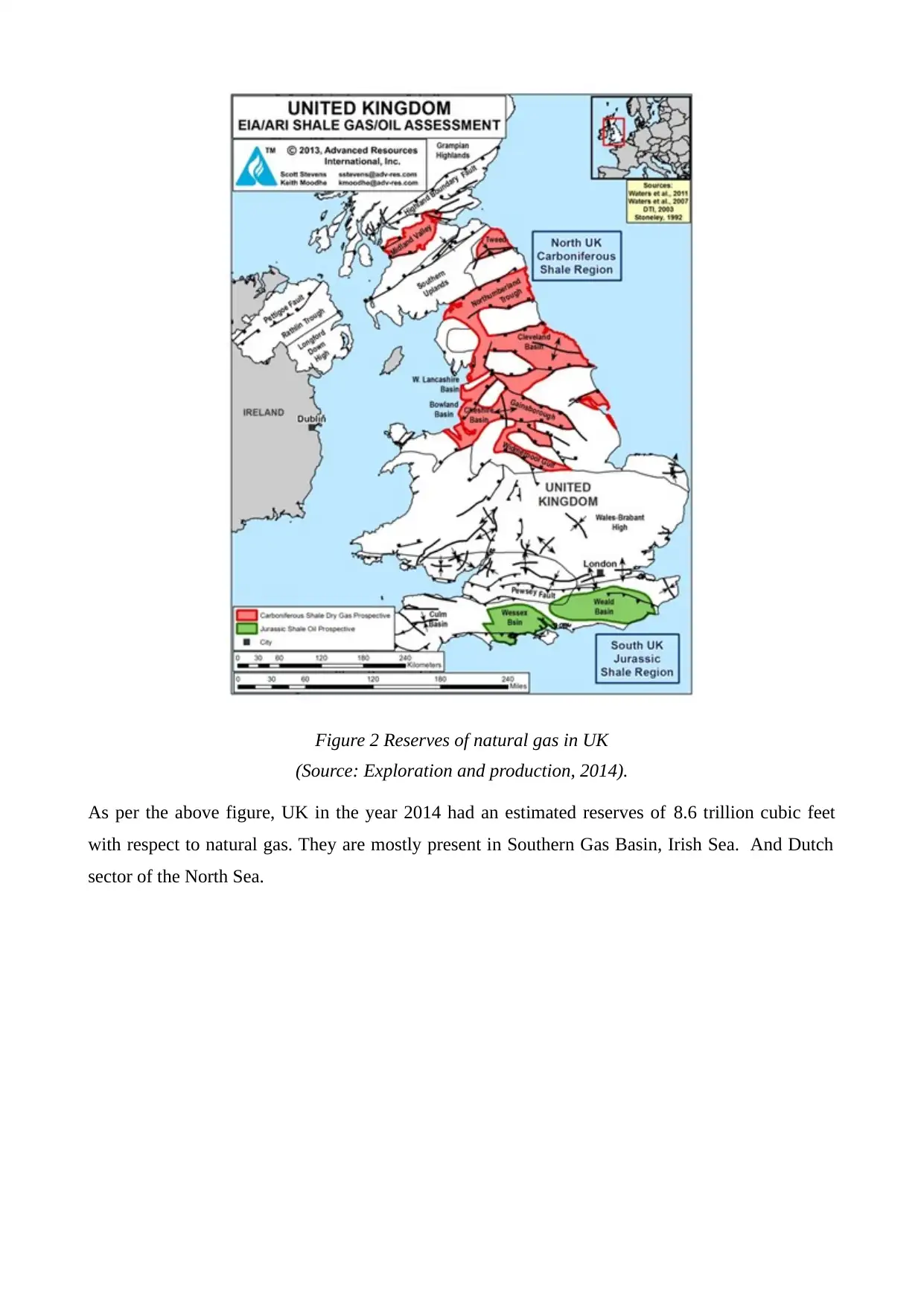
Figure 2 Reserves of natural gas in UK
(Source: Exploration and production, 2014).
As per the above figure, UK in the year 2014 had an estimated reserves of 8.6 trillion cubic feet
with respect to natural gas. They are mostly present in Southern Gas Basin, Irish Sea. And Dutch
sector of the North Sea.
(Source: Exploration and production, 2014).
As per the above figure, UK in the year 2014 had an estimated reserves of 8.6 trillion cubic feet
with respect to natural gas. They are mostly present in Southern Gas Basin, Irish Sea. And Dutch
sector of the North Sea.
Paraphrase This Document
Need a fresh take? Get an instant paraphrase of this document with our AI Paraphraser
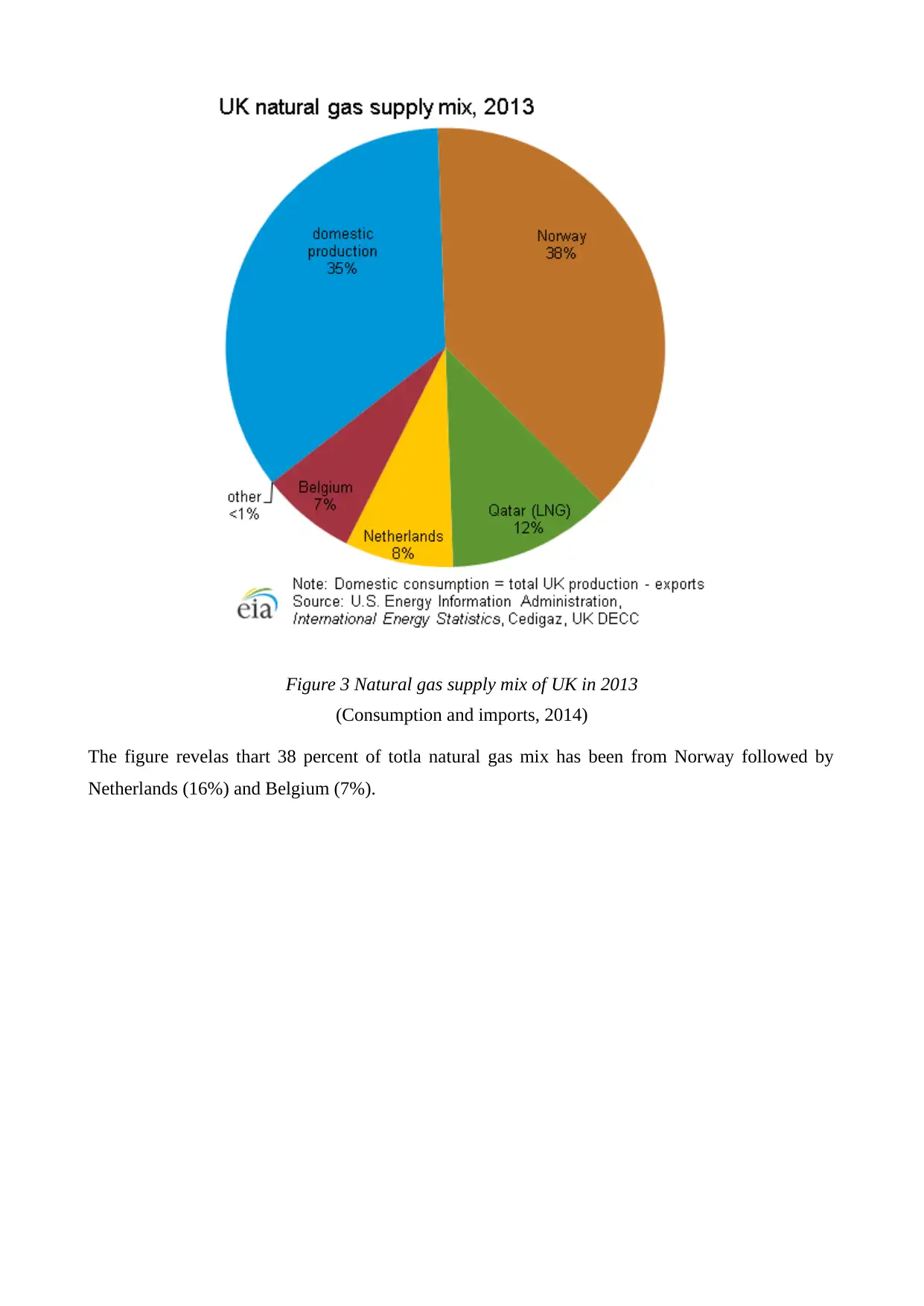
Figure 3 Natural gas supply mix of UK in 2013
(Consumption and imports, 2014)
The figure revelas thart 38 percent of totla natural gas mix has been from Norway followed by
Netherlands (16%) and Belgium (7%).
(Consumption and imports, 2014)
The figure revelas thart 38 percent of totla natural gas mix has been from Norway followed by
Netherlands (16%) and Belgium (7%).
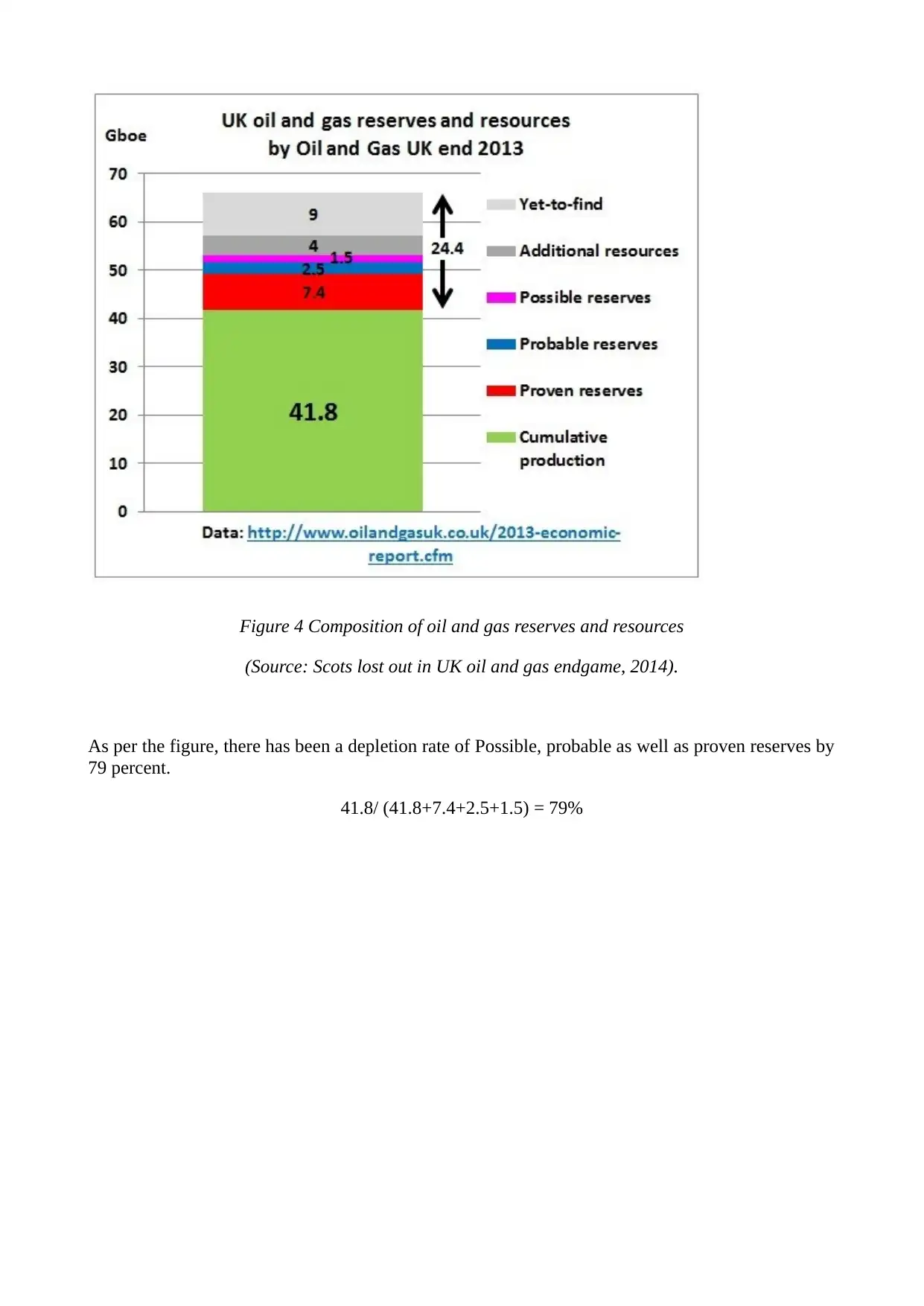
Figure 4 Composition of oil and gas reserves and resources
(Source: Scots lost out in UK oil and gas endgame, 2014).
As per the figure, there has been a depletion rate of Possible, probable as well as proven reserves by
79 percent.
41.8/ (41.8+7.4+2.5+1.5) = 79%
(Source: Scots lost out in UK oil and gas endgame, 2014).
As per the figure, there has been a depletion rate of Possible, probable as well as proven reserves by
79 percent.
41.8/ (41.8+7.4+2.5+1.5) = 79%
⊘ This is a preview!⊘
Do you want full access?
Subscribe today to unlock all pages.

Trusted by 1+ million students worldwide
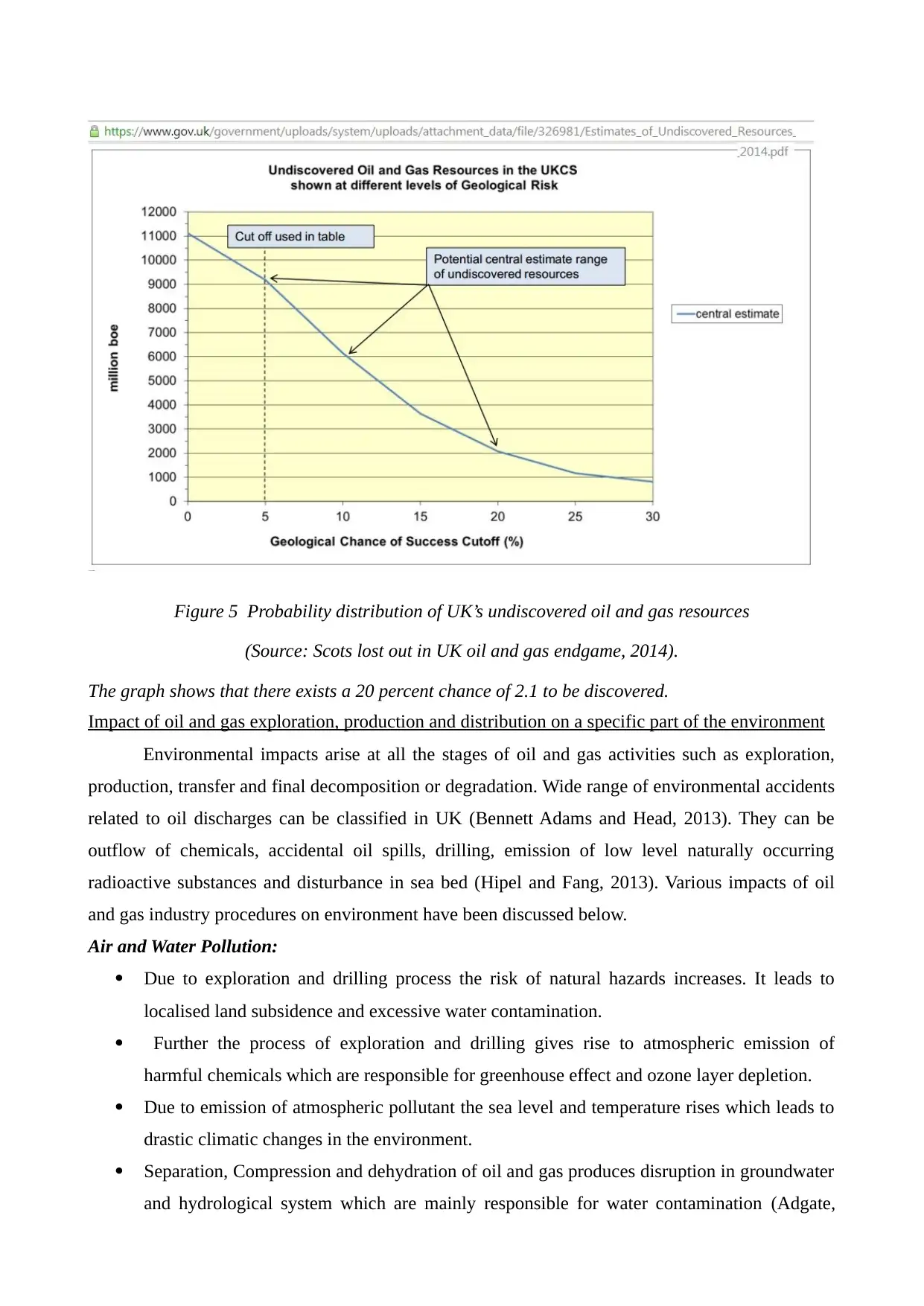
Figure 5 Probability distribution of UK’s undiscovered oil and gas resources
(Source: Scots lost out in UK oil and gas endgame, 2014).
The graph shows that there exists a 20 percent chance of 2.1 to be discovered.
Impact of oil and gas exploration, production and distribution on a specific part of the environment
Environmental impacts arise at all the stages of oil and gas activities such as exploration,
production, transfer and final decomposition or degradation. Wide range of environmental accidents
related to oil discharges can be classified in UK (Bennett Adams and Head, 2013). They can be
outflow of chemicals, accidental oil spills, drilling, emission of low level naturally occurring
radioactive substances and disturbance in sea bed (Hipel and Fang, 2013). Various impacts of oil
and gas industry procedures on environment have been discussed below.
Air and Water Pollution:
Due to exploration and drilling process the risk of natural hazards increases. It leads to
localised land subsidence and excessive water contamination.
Further the process of exploration and drilling gives rise to atmospheric emission of
harmful chemicals which are responsible for greenhouse effect and ozone layer depletion.
Due to emission of atmospheric pollutant the sea level and temperature rises which leads to
drastic climatic changes in the environment.
Separation, Compression and dehydration of oil and gas produces disruption in groundwater
and hydrological system which are mainly responsible for water contamination (Adgate,
(Source: Scots lost out in UK oil and gas endgame, 2014).
The graph shows that there exists a 20 percent chance of 2.1 to be discovered.
Impact of oil and gas exploration, production and distribution on a specific part of the environment
Environmental impacts arise at all the stages of oil and gas activities such as exploration,
production, transfer and final decomposition or degradation. Wide range of environmental accidents
related to oil discharges can be classified in UK (Bennett Adams and Head, 2013). They can be
outflow of chemicals, accidental oil spills, drilling, emission of low level naturally occurring
radioactive substances and disturbance in sea bed (Hipel and Fang, 2013). Various impacts of oil
and gas industry procedures on environment have been discussed below.
Air and Water Pollution:
Due to exploration and drilling process the risk of natural hazards increases. It leads to
localised land subsidence and excessive water contamination.
Further the process of exploration and drilling gives rise to atmospheric emission of
harmful chemicals which are responsible for greenhouse effect and ozone layer depletion.
Due to emission of atmospheric pollutant the sea level and temperature rises which leads to
drastic climatic changes in the environment.
Separation, Compression and dehydration of oil and gas produces disruption in groundwater
and hydrological system which are mainly responsible for water contamination (Adgate,
Paraphrase This Document
Need a fresh take? Get an instant paraphrase of this document with our AI Paraphraser
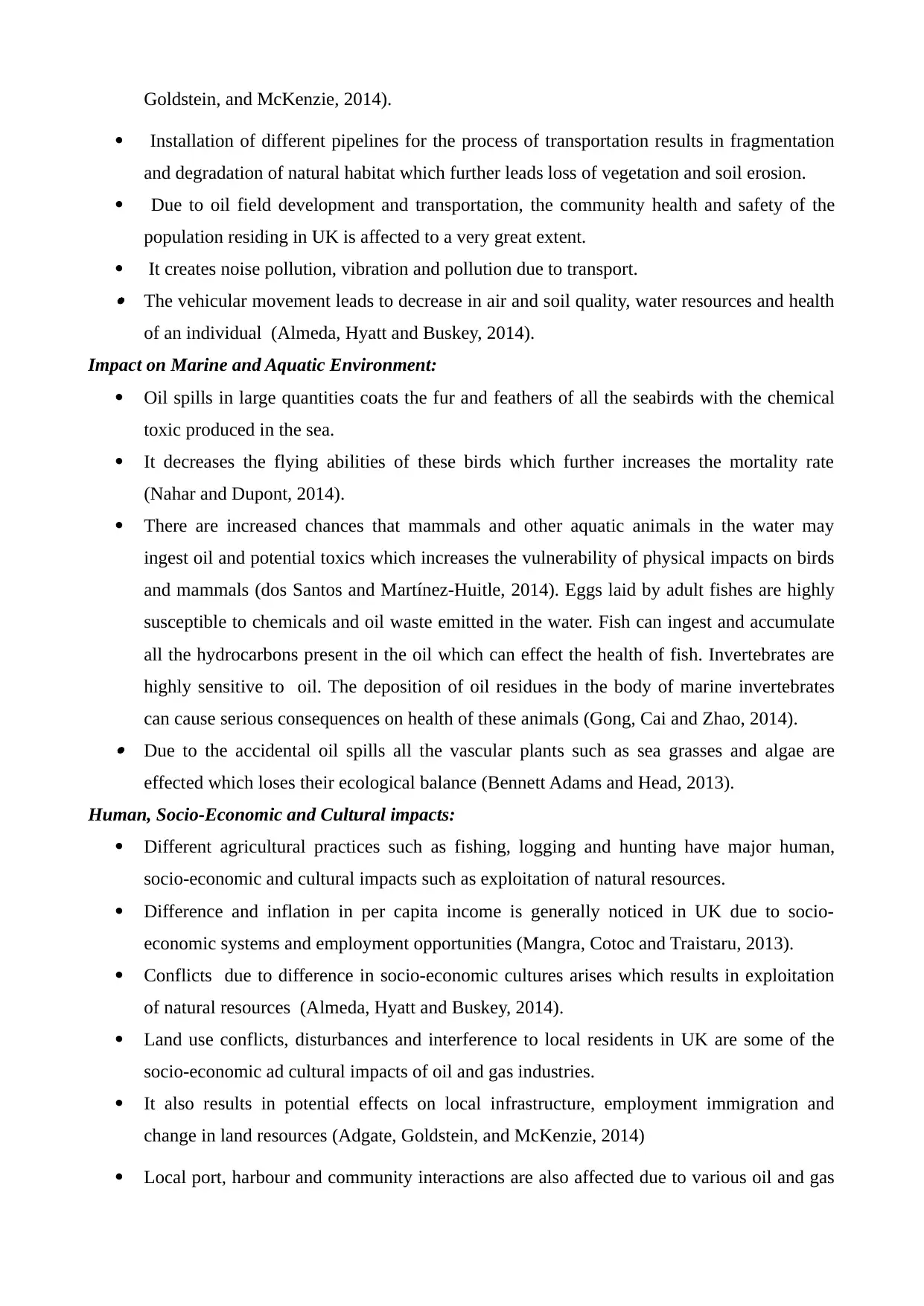
Goldstein, and McKenzie, 2014).
Installation of different pipelines for the process of transportation results in fragmentation
and degradation of natural habitat which further leads loss of vegetation and soil erosion.
Due to oil field development and transportation, the community health and safety of the
population residing in UK is affected to a very great extent.
It creates noise pollution, vibration and pollution due to transport. The vehicular movement leads to decrease in air and soil quality, water resources and health
of an individual (Almeda, Hyatt and Buskey, 2014).
Impact on Marine and Aquatic Environment:
Oil spills in large quantities coats the fur and feathers of all the seabirds with the chemical
toxic produced in the sea.
It decreases the flying abilities of these birds which further increases the mortality rate
(Nahar and Dupont, 2014).
There are increased chances that mammals and other aquatic animals in the water may
ingest oil and potential toxics which increases the vulnerability of physical impacts on birds
and mammals (dos Santos and Martínez-Huitle, 2014). Eggs laid by adult fishes are highly
susceptible to chemicals and oil waste emitted in the water. Fish can ingest and accumulate
all the hydrocarbons present in the oil which can effect the health of fish. Invertebrates are
highly sensitive to oil. The deposition of oil residues in the body of marine invertebrates
can cause serious consequences on health of these animals (Gong, Cai and Zhao, 2014). Due to the accidental oil spills all the vascular plants such as sea grasses and algae are
effected which loses their ecological balance (Bennett Adams and Head, 2013).
Human, Socio-Economic and Cultural impacts:
Different agricultural practices such as fishing, logging and hunting have major human,
socio-economic and cultural impacts such as exploitation of natural resources.
Difference and inflation in per capita income is generally noticed in UK due to socio-
economic systems and employment opportunities (Mangra, Cotoc and Traistaru, 2013).
Conflicts due to difference in socio-economic cultures arises which results in exploitation
of natural resources (Almeda, Hyatt and Buskey, 2014).
Land use conflicts, disturbances and interference to local residents in UK are some of the
socio-economic ad cultural impacts of oil and gas industries.
It also results in potential effects on local infrastructure, employment immigration and
change in land resources (Adgate, Goldstein, and McKenzie, 2014)
Local port, harbour and community interactions are also affected due to various oil and gas
Installation of different pipelines for the process of transportation results in fragmentation
and degradation of natural habitat which further leads loss of vegetation and soil erosion.
Due to oil field development and transportation, the community health and safety of the
population residing in UK is affected to a very great extent.
It creates noise pollution, vibration and pollution due to transport. The vehicular movement leads to decrease in air and soil quality, water resources and health
of an individual (Almeda, Hyatt and Buskey, 2014).
Impact on Marine and Aquatic Environment:
Oil spills in large quantities coats the fur and feathers of all the seabirds with the chemical
toxic produced in the sea.
It decreases the flying abilities of these birds which further increases the mortality rate
(Nahar and Dupont, 2014).
There are increased chances that mammals and other aquatic animals in the water may
ingest oil and potential toxics which increases the vulnerability of physical impacts on birds
and mammals (dos Santos and Martínez-Huitle, 2014). Eggs laid by adult fishes are highly
susceptible to chemicals and oil waste emitted in the water. Fish can ingest and accumulate
all the hydrocarbons present in the oil which can effect the health of fish. Invertebrates are
highly sensitive to oil. The deposition of oil residues in the body of marine invertebrates
can cause serious consequences on health of these animals (Gong, Cai and Zhao, 2014). Due to the accidental oil spills all the vascular plants such as sea grasses and algae are
effected which loses their ecological balance (Bennett Adams and Head, 2013).
Human, Socio-Economic and Cultural impacts:
Different agricultural practices such as fishing, logging and hunting have major human,
socio-economic and cultural impacts such as exploitation of natural resources.
Difference and inflation in per capita income is generally noticed in UK due to socio-
economic systems and employment opportunities (Mangra, Cotoc and Traistaru, 2013).
Conflicts due to difference in socio-economic cultures arises which results in exploitation
of natural resources (Almeda, Hyatt and Buskey, 2014).
Land use conflicts, disturbances and interference to local residents in UK are some of the
socio-economic ad cultural impacts of oil and gas industries.
It also results in potential effects on local infrastructure, employment immigration and
change in land resources (Adgate, Goldstein, and McKenzie, 2014)
Local port, harbour and community interactions are also affected due to various oil and gas
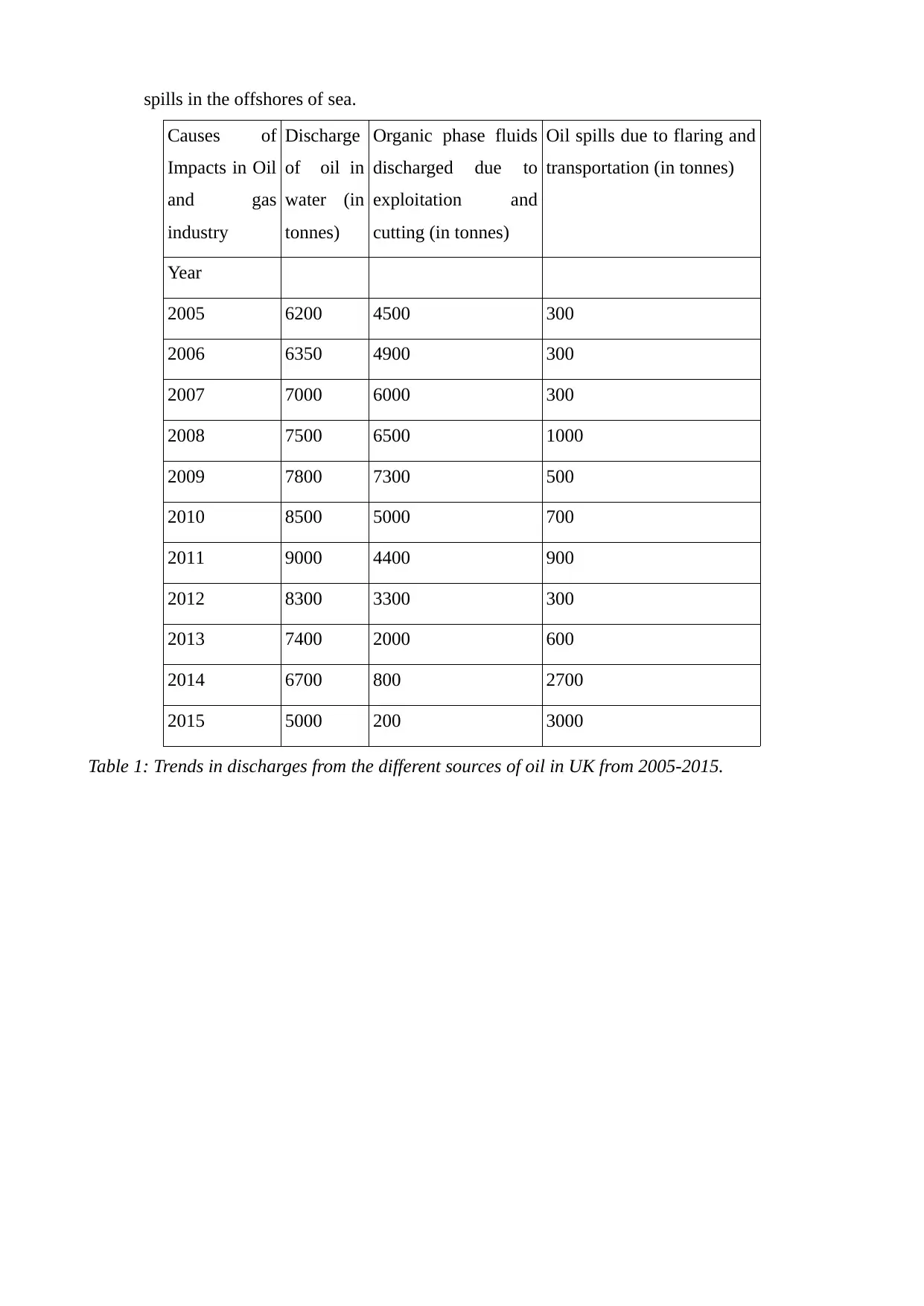
spills in the offshores of sea.
Causes of
Impacts in Oil
and gas
industry
Discharge
of oil in
water (in
tonnes)
Organic phase fluids
discharged due to
exploitation and
cutting (in tonnes)
Oil spills due to flaring and
transportation (in tonnes)
Year
2005 6200 4500 300
2006 6350 4900 300
2007 7000 6000 300
2008 7500 6500 1000
2009 7800 7300 500
2010 8500 5000 700
2011 9000 4400 900
2012 8300 3300 300
2013 7400 2000 600
2014 6700 800 2700
2015 5000 200 3000
Table 1: Trends in discharges from the different sources of oil in UK from 2005-2015.
Causes of
Impacts in Oil
and gas
industry
Discharge
of oil in
water (in
tonnes)
Organic phase fluids
discharged due to
exploitation and
cutting (in tonnes)
Oil spills due to flaring and
transportation (in tonnes)
Year
2005 6200 4500 300
2006 6350 4900 300
2007 7000 6000 300
2008 7500 6500 1000
2009 7800 7300 500
2010 8500 5000 700
2011 9000 4400 900
2012 8300 3300 300
2013 7400 2000 600
2014 6700 800 2700
2015 5000 200 3000
Table 1: Trends in discharges from the different sources of oil in UK from 2005-2015.
⊘ This is a preview!⊘
Do you want full access?
Subscribe today to unlock all pages.

Trusted by 1+ million students worldwide
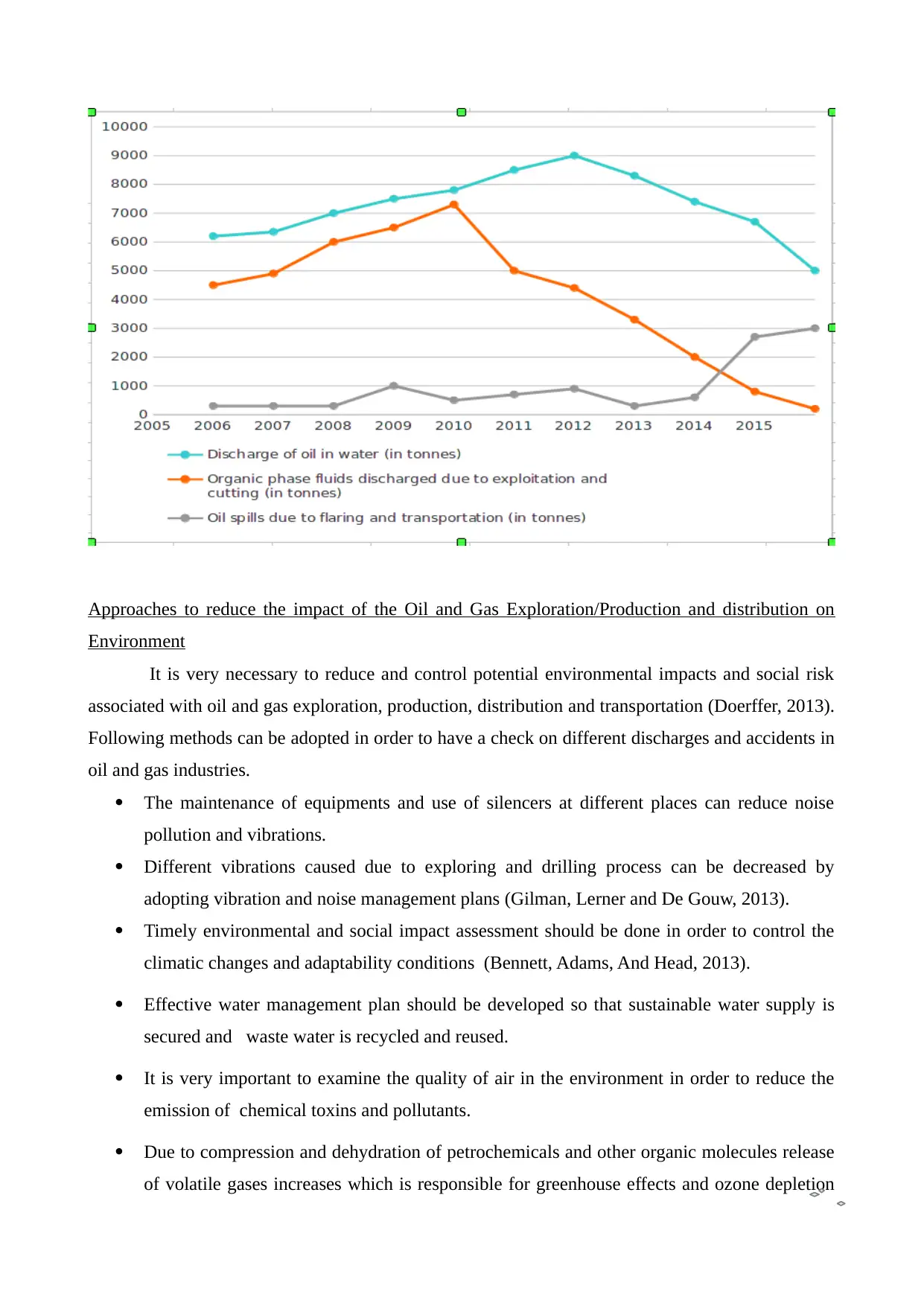
Approaches to reduce the impact of the Oil and Gas Exploration/Production and distribution on
Environment
It is very necessary to reduce and control potential environmental impacts and social risk
associated with oil and gas exploration, production, distribution and transportation (Doerffer, 2013).
Following methods can be adopted in order to have a check on different discharges and accidents in
oil and gas industries.
The maintenance of equipments and use of silencers at different places can reduce noise
pollution and vibrations.
Different vibrations caused due to exploring and drilling process can be decreased by
adopting vibration and noise management plans (Gilman, Lerner and De Gouw, 2013).
Timely environmental and social impact assessment should be done in order to control the
climatic changes and adaptability conditions (Bennett, Adams, And Head, 2013).
Effective water management plan should be developed so that sustainable water supply is
secured and waste water is recycled and reused.
It is very important to examine the quality of air in the environment in order to reduce the
emission of chemical toxins and pollutants.
Due to compression and dehydration of petrochemicals and other organic molecules release
of volatile gases increases which is responsible for greenhouse effects and ozone depletion
Environment
It is very necessary to reduce and control potential environmental impacts and social risk
associated with oil and gas exploration, production, distribution and transportation (Doerffer, 2013).
Following methods can be adopted in order to have a check on different discharges and accidents in
oil and gas industries.
The maintenance of equipments and use of silencers at different places can reduce noise
pollution and vibrations.
Different vibrations caused due to exploring and drilling process can be decreased by
adopting vibration and noise management plans (Gilman, Lerner and De Gouw, 2013).
Timely environmental and social impact assessment should be done in order to control the
climatic changes and adaptability conditions (Bennett, Adams, And Head, 2013).
Effective water management plan should be developed so that sustainable water supply is
secured and waste water is recycled and reused.
It is very important to examine the quality of air in the environment in order to reduce the
emission of chemical toxins and pollutants.
Due to compression and dehydration of petrochemicals and other organic molecules release
of volatile gases increases which is responsible for greenhouse effects and ozone depletion
Paraphrase This Document
Need a fresh take? Get an instant paraphrase of this document with our AI Paraphraser
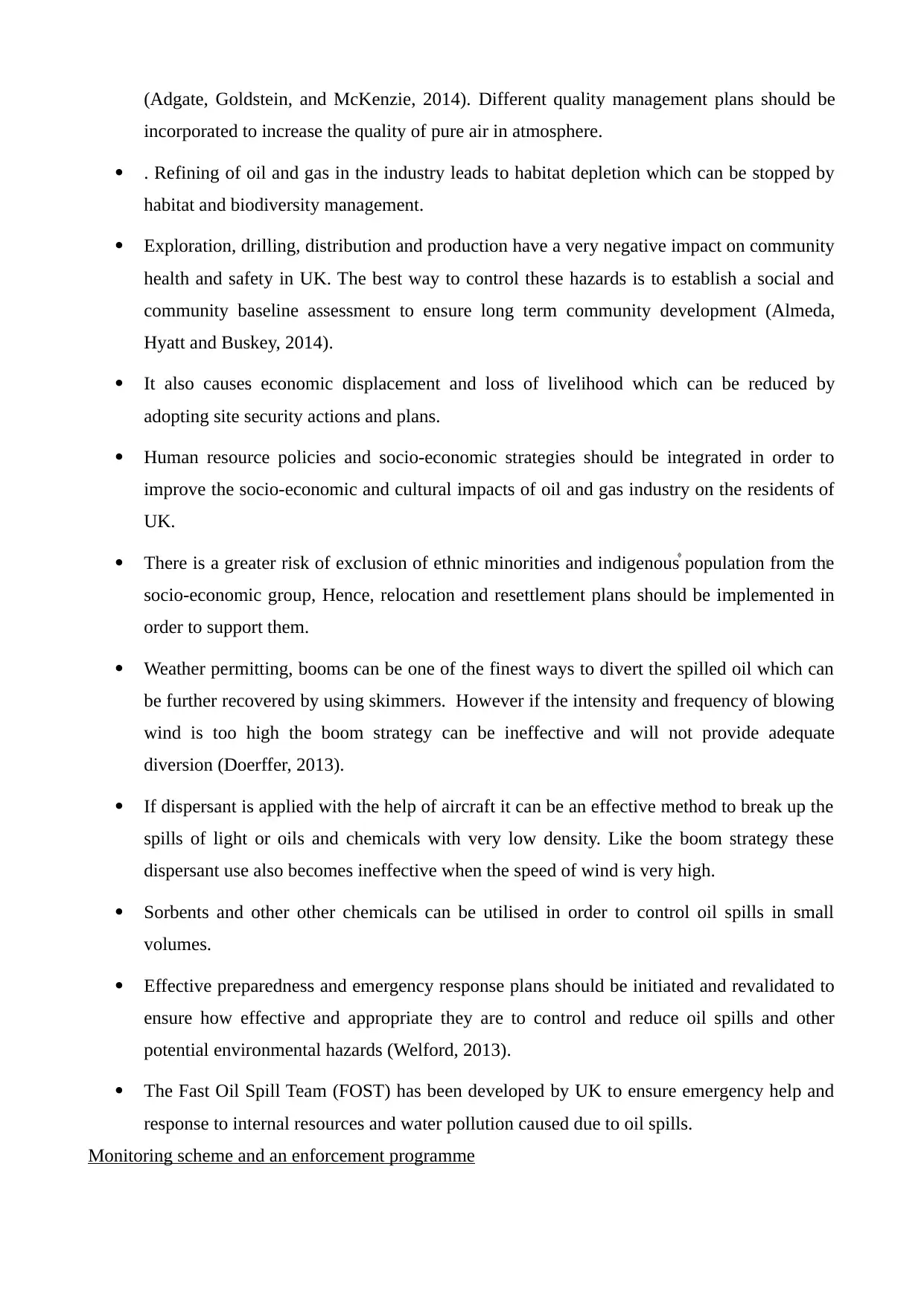
(Adgate, Goldstein, and McKenzie, 2014). Different quality management plans should be
incorporated to increase the quality of pure air in atmosphere.
. Refining of oil and gas in the industry leads to habitat depletion which can be stopped by
habitat and biodiversity management.
Exploration, drilling, distribution and production have a very negative impact on community
health and safety in UK. The best way to control these hazards is to establish a social and
community baseline assessment to ensure long term community development (Almeda,
Hyatt and Buskey, 2014).
It also causes economic displacement and loss of livelihood which can be reduced by
adopting site security actions and plans.
Human resource policies and socio-economic strategies should be integrated in order to
improve the socio-economic and cultural impacts of oil and gas industry on the residents of
UK.
There is a greater risk of exclusion of ethnic minorities and indigenous population from the
socio-economic group, Hence, relocation and resettlement plans should be implemented in
order to support them.
Weather permitting, booms can be one of the finest ways to divert the spilled oil which can
be further recovered by using skimmers. However if the intensity and frequency of blowing
wind is too high the boom strategy can be ineffective and will not provide adequate
diversion (Doerffer, 2013).
If dispersant is applied with the help of aircraft it can be an effective method to break up the
spills of light or oils and chemicals with very low density. Like the boom strategy these
dispersant use also becomes ineffective when the speed of wind is very high.
Sorbents and other other chemicals can be utilised in order to control oil spills in small
volumes.
Effective preparedness and emergency response plans should be initiated and revalidated to
ensure how effective and appropriate they are to control and reduce oil spills and other
potential environmental hazards (Welford, 2013).
The Fast Oil Spill Team (FOST) has been developed by UK to ensure emergency help and
response to internal resources and water pollution caused due to oil spills.
Monitoring scheme and an enforcement programme
incorporated to increase the quality of pure air in atmosphere.
. Refining of oil and gas in the industry leads to habitat depletion which can be stopped by
habitat and biodiversity management.
Exploration, drilling, distribution and production have a very negative impact on community
health and safety in UK. The best way to control these hazards is to establish a social and
community baseline assessment to ensure long term community development (Almeda,
Hyatt and Buskey, 2014).
It also causes economic displacement and loss of livelihood which can be reduced by
adopting site security actions and plans.
Human resource policies and socio-economic strategies should be integrated in order to
improve the socio-economic and cultural impacts of oil and gas industry on the residents of
UK.
There is a greater risk of exclusion of ethnic minorities and indigenous population from the
socio-economic group, Hence, relocation and resettlement plans should be implemented in
order to support them.
Weather permitting, booms can be one of the finest ways to divert the spilled oil which can
be further recovered by using skimmers. However if the intensity and frequency of blowing
wind is too high the boom strategy can be ineffective and will not provide adequate
diversion (Doerffer, 2013).
If dispersant is applied with the help of aircraft it can be an effective method to break up the
spills of light or oils and chemicals with very low density. Like the boom strategy these
dispersant use also becomes ineffective when the speed of wind is very high.
Sorbents and other other chemicals can be utilised in order to control oil spills in small
volumes.
Effective preparedness and emergency response plans should be initiated and revalidated to
ensure how effective and appropriate they are to control and reduce oil spills and other
potential environmental hazards (Welford, 2013).
The Fast Oil Spill Team (FOST) has been developed by UK to ensure emergency help and
response to internal resources and water pollution caused due to oil spills.
Monitoring scheme and an enforcement programme
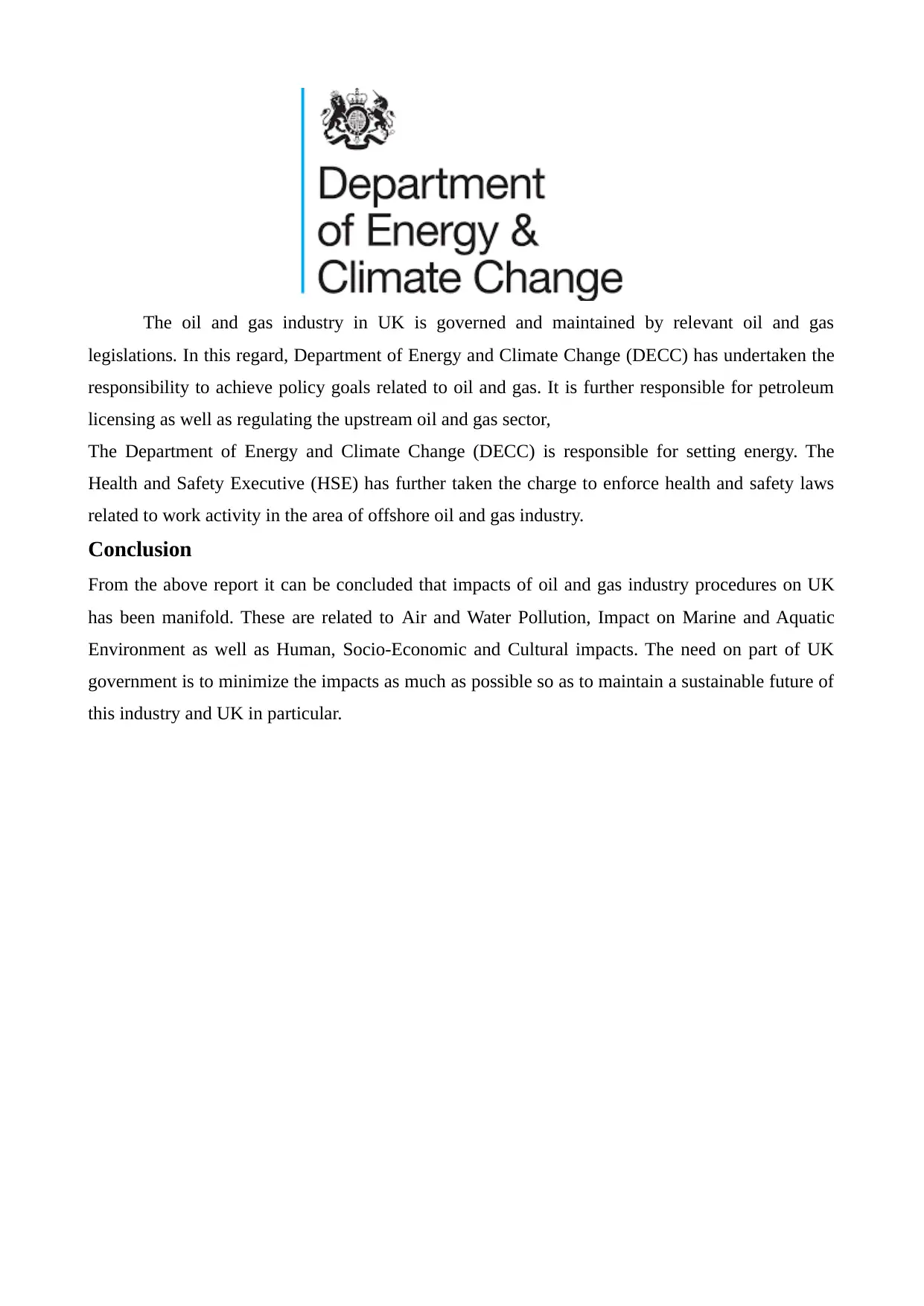
The oil and gas industry in UK is governed and maintained by relevant oil and gas
legislations. In this regard, Department of Energy and Climate Change (DECC) has undertaken the
responsibility to achieve policy goals related to oil and gas. It is further responsible for petroleum
licensing as well as regulating the upstream oil and gas sector,
The Department of Energy and Climate Change (DECC) is responsible for setting energy. The
Health and Safety Executive (HSE) has further taken the charge to enforce health and safety laws
related to work activity in the area of offshore oil and gas industry.
Conclusion
From the above report it can be concluded that impacts of oil and gas industry procedures on UK
has been manifold. These are related to Air and Water Pollution, Impact on Marine and Aquatic
Environment as well as Human, Socio-Economic and Cultural impacts. The need on part of UK
government is to minimize the impacts as much as possible so as to maintain a sustainable future of
this industry and UK in particular.
legislations. In this regard, Department of Energy and Climate Change (DECC) has undertaken the
responsibility to achieve policy goals related to oil and gas. It is further responsible for petroleum
licensing as well as regulating the upstream oil and gas sector,
The Department of Energy and Climate Change (DECC) is responsible for setting energy. The
Health and Safety Executive (HSE) has further taken the charge to enforce health and safety laws
related to work activity in the area of offshore oil and gas industry.
Conclusion
From the above report it can be concluded that impacts of oil and gas industry procedures on UK
has been manifold. These are related to Air and Water Pollution, Impact on Marine and Aquatic
Environment as well as Human, Socio-Economic and Cultural impacts. The need on part of UK
government is to minimize the impacts as much as possible so as to maintain a sustainable future of
this industry and UK in particular.
⊘ This is a preview!⊘
Do you want full access?
Subscribe today to unlock all pages.

Trusted by 1+ million students worldwide
1 out of 14
Related Documents
Your All-in-One AI-Powered Toolkit for Academic Success.
+13062052269
info@desklib.com
Available 24*7 on WhatsApp / Email
![[object Object]](/_next/static/media/star-bottom.7253800d.svg)
Unlock your academic potential
Copyright © 2020–2025 A2Z Services. All Rights Reserved. Developed and managed by ZUCOL.




